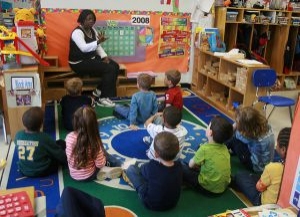Supporting a toddler through moments of heightened emotion requires patience and thoughtful strategies. Here are some effective de-escalation techniques you can try. The following article provides information on De-escalation Strategies During A Tantrum, De-escalation Strategies During Separation Anxiety, De-escalation Strategies When A Toddler's Crying, De-escalation Strategies When A Toddler Hits. De-escalation When A Toddler Screams, De-escalation Strategies When A Toddler Bites and more.
De-escalation Strategies
- Stay calm— your tone and body language set the tone. A calm demeanor helps the child feel safe.
- Validate Their Feelings— Acknowledge their emotions without reinforcing negative behavior. Saying, “I see you’re upset,” can help them feel heard.
- Respect Personal Space—Some toddlers need a little distance to regulate their emotions.
- Use Simple Choices—Giving them a choice (e.g., “Would you like to sit here or there?”) can help them regain a sense of control.
- Distraction—Redirecting their attention to a preferred activity or object can shift their focus.
- Deep Breathing Exercises—Encouraging slow breaths can help them calm down.
- Reduce Stimulation—If sensory overload is a factor, dimming lights or lowering noise levels can be helpful.
- Offer a Movement Break – Some children regulate better through physical activity, like a short walk or stretching.
- Use Calming Visuals – Gentle images or soft colors can provide a soothing effect.
De-escalation Strategies During A Tantrum
When a toddler is in full tantrum mode, their brain is in survival mode—logic and reasoning are offline. Here are targeted de-escalation strategies to help you navigate those stormy moments:
-
Stay Silent and Present – Sometimes, less is more. Sit nearby, stay calm, and let them ride the emotional wave while knowing you're there.
-
Get Low and Soften Your Body Language – Crouch to their level, avoid direct eye contact, and keep your posture relaxed. This feels less threatening and more supportive.
-
Name the Feeling, Not the Behavior – Try, “You’re feeling really frustrated,” instead of “Stop yelling.” This helps them feel seen without reinforcing the outburst.
-
Avoid Demands or Logic Mid-Tantrum – Their brain can’t process instructions right now. Wait until they’re calm to talk things through.
-
Offer a Calming Choice – “Would you like your soft toy or your cushion?” Simple, binary choices can help them regain a sense of control.
-
Use a Comfort Object or Calming Tool – A familiar item, sensory bottle, or even a soft scarf to fidget with can help ground them.
-
Reduce Stimulation – Dim lights, lower noise, and clear the space of extra people if possible. A calm environment supports a calm body.
-
Movement Break – If safe, offer a short walk, a stretch, or even a “shake it out” dance to help release tension.
-
Model Deep Breathing – Don’t force it—just do it yourself. Toddlers often mirror adult behavior when they’re ready.
-
Debrief Later – Once calm, revisit the moment gently: “You were really upset when we had to leave the park. Next time, we can try a countdown.”
De-escalation Strategies During Separation Anxiety
Separation anxiety in toddlers can be intense, especially during drop-off times. The key is to create a sense of safety and predictability while gently supporting their growing independence. Here are some de-escalation strategies tailored to separation anxiety:
-
Create a Predictable Goodbye Ritual
A consistent, short routine—like a hug, a wave at the window, or a special phrase—can provide comfort and signal that separation is safe and temporary. -
Use Visual Timers or Picture Schedules
Showing them what comes next (e.g., “After you say goodbye, it’s playtime, then snack”) helps reduce uncertainty and gives them a sense of control. -
Acknowledge Their Feelings Without Over-Explaining
Try: “It’s okay to feel sad. I’ll be back after rest time.” Keep it simple and reassuring. -
Offer a Transitional Object
A small photo of their family, a familiar toy, or even a “hug button” (a sticker they can press when they miss home) can be incredibly grounding. -
Stay Calm and Confident
Children mirror adult emotions. If you appear anxious or hesitant, they’ll pick up on it. A warm, confident tone helps them feel secure. -
Use Gentle Distraction
Invite them into a favorite activity or sensory play setup. “Let’s squish the playdough together before story time.” -
Create a “Safe Spot”
A cozy corner with soft textures, calming visuals, and a few comfort items can help them self-regulate when emotions run high. -
Involve Them in the Transition
Let them carry their own bag or choose a toy to bring in. This gives them a sense of agency and purpose. -
Collaborate with Families
Share strategies and ask what works at home. Consistency between home and care settings can ease the transition.
De-escalation Strategies When A Toddler's Crying
When a toddler is crying—whether from frustration, sadness, or overwhelm—they’re signaling a need, not just making noise. Here are gentle, effective de-escalation strategies to support them through those teary moments:
-
Stay Close and Regulate Yourself
Your calm presence is powerful. Sit nearby, breathe slowly, and let your body language say, “You’re safe.” -
Acknowledge Without Fixing
Try: “You’re feeling really upset right now.” Avoid rushing to stop the crying—validation helps them feel seen. -
Use a Soft, Rhythmic Voice
Speak slowly and gently. A soothing tone can help regulate their nervous system. -
Offer a Comforting Object
A soft toy, blanket, or sensory item can provide grounding and familiarity. -
Minimize Stimulation
Dim lights, reduce noise, and clear the space if needed. A calm environment supports emotional recovery. -
Mirror Their Breathing (When Ready)
Once the crying slows, model slow, deep breaths. Toddlers often mirror your rhythm when they’re ready. -
Use Gentle Touch (If Welcomed)
A hand on the back or a cuddle can be reassuring—but always follow their cues. -
Redirect with Purpose
When they’re ready, offer a calming activity like water play, playdough, or a favorite book. -
Narrate the Moment
“You were sad when Mum left. That’s really hard. Now we’re together, and we’re safe.” This helps them make sense of their feelings. -
Debrief Later
Once calm, revisit the moment gently. This builds emotional literacy and trust.
De-escalation Strategies When A Toddler Hits
When a toddler hits, it’s often a sign of overwhelm, not malice. Their impulse control is still developing, and they’re communicating through action rather than words. Here are compassionate, firm de-escalation strategies to guide them safely:
-
Stay Calm and Grounded
Your steady presence is key. Take a breath, lower your voice, and keep your body language open and non-threatening. -
Block, Don’t Punish
Gently hold their hands or place a soft object between you and them to prevent further hitting—without shaming or scolding. -
Name the Emotion, Not the Behavior
“You’re feeling really angry right now.” This helps them connect feelings to words instead of actions. -
Set a Clear, Simple Boundary
“I won’t let you hit. Hitting hurts.” Keep it short and consistent every time. -
Offer a Safe Outlet
Redirect the energy: “You can hit this pillow,” or “Let’s stomp our feet instead.” -
Use Visuals or Social Stories
A simple picture chart showing “gentle hands” or a short story about kind touch can reinforce expectations. -
Model Gentle Touch
Show them what “gentle” looks and feels like. Invite them to try it with a toy or your hand. -
Create a Calm-Down Space
A cozy corner with soft textures, calming visuals, and sensory tools can help them reset. -
Debrief Later
Once calm, revisit the moment: “You were upset when we had to clean up. Next time, we can use our words or ask for help.” -
Track Triggers
Keep a log of when hitting happens—before transitions, during group time, etc. Patterns can reveal unmet needs or sensory sensitivities.
De-escalation When A Toddler Screams
When a toddler screams, it’s often their way of expressing overwhelm, frustration, or a need they can’t yet verbalize. Here are soothing, toddler-friendly de-escalation strategies to help you respond with calm and clarity:
-
Lower Your Own Volume
Resist the urge to match their intensity. Speak softly and slowly—your calm tone can help regulate theirs. -
Acknowledge the Emotion
“You’re really upset right now.” Naming the feeling helps them feel understood and begins the path to regulation. -
Use Visual or Gestural Cues
A hand on your heart, a finger to your lips, or a visual calm-down card can communicate more effectively than words in the moment. -
Offer a Safe Outlet
“Let’s roar into this pillow!” or “Can we stomp our feet like dinosaurs?” Channeling the energy into something physical but safe can be a game-changer. -
Minimize Sensory Input
If possible, reduce noise, dim lights, or move to a quieter space. Screaming often escalates in overstimulating environments. -
Model Deep Breathing
Blow bubbles, pretend to blow out candles, or use a pinwheel—these playful visuals can encourage slow breaths without pressure. -
Use a Comfort Object or Sensory Tool
A soft toy, squishy ball, or textured fabric can help gr
ound them when emotions are big. -
Stay Close, But Give Space
Some toddlers want a hug; others need a little distance. Let them know you’re nearby and available when they’re ready. -
Redirect Gently
“Let’s check on the teddy in the reading corner,” or “Can you help me find the blue block?” A purposeful shift in focus can ease the intensity. -
Debrief Later
Once calm, revisit the moment: “You were really loud when we had to stop playing. Next time, we can use our ‘I’m mad’ voice instead.”
De-escalation When A Toddler Bites
When a toddler bites, it’s often a signal of unmet needs—communication struggles, sensory overload, or even teething discomfort. Here are compassionate, clear de-escalation strategies to guide them safely and supportively:
-
Stay Calm and Neutral
Reacting with shock or anger can escalate the moment. Use a steady, low voice and relaxed body language to model regulation. -
Block and Redirect
Gently place your hand between the child and their target if you anticipate a bite. Offer a safe alternative: “You can bite this teether, not your friend.” -
Name the Emotion, Not the Behavior
“You’re feeling really frustrated.” This helps them connect feelings to words instead of actions. -
Set a Clear, Consistent Boundary
“I won’t let you bite. Biting hurts.” Keep it short, firm, and kind—every time. -
Offer a Sensory Substitute
A chewy toy, cold washcloth, or textured object can meet oral sensory needs in a safe way. -
Use Visual Supports
A “gentle hands” chart or social story about kind touch can reinforce expectations in a toddler-friendly way. -
Model Gentle Touch
Show them how to be gentle with a toy or your hand. Invite them to try it too. -
Create a Calm-Down Space
A cozy corner with soft textures, calming visuals, and sensory tools can help them reset after a bite. -
Debrief Later
Once calm, revisit the moment: “You were upset when the toy was taken. Next time, let’s use our words or ask for help.” -
Track Patterns
Keep a log of when biting happens—before transitions, during group play, etc. This can reveal triggers like fatigue, hunger, or overstimulation.
If you’d like, I can help you design a toddler-friendly “gentle hands” visual or a sensory toolkit tailored to your classroom. Want to explore that together?
Further Reading
Supporting Toddlers With Challenging Behaviour
Descriptive Words For Children's Behaviour
Strategies To Support Toddlers With Challenging Behaviour







 Working as a childcare professional can be a challenge especially when dealing with behavioural problems which may arise. The techniques we use when dealing with
Working as a childcare professional can be a challenge especially when dealing with behavioural problems which may arise. The techniques we use when dealing with There are different types of behaviour that children can display and sometimes it can be hard to manage, especially if a child is having behavioural
There are different types of behaviour that children can display and sometimes it can be hard to manage, especially if a child is having behavioural As a parent, your behavioural expectations of your child can be higher than what is actually developmentally appropriate for your child's age.
As a parent, your behavioural expectations of your child can be higher than what is actually developmentally appropriate for your child's age.
 As Educators, there will be many instances where you will need to write about a child's behaviour. For a behaviour management plan, assessments, half-yearly or
As Educators, there will be many instances where you will need to write about a child's behaviour. For a behaviour management plan, assessments, half-yearly or As Educators when communicating with Parents (through verbal or non-verbal communication), there will be times where we need to discuss issues or concerns that may
As Educators when communicating with Parents (through verbal or non-verbal communication), there will be times where we need to discuss issues or concerns that may Challenging Behaviour is when a child does something that hurts themselves and/or other people.
Challenging Behaviour is when a child does something that hurts themselves and/or other people.
 As part of your child's development it is normal for your child to have anxiety and fears. A baby commonly shows a fearful sign to
As part of your child's development it is normal for your child to have anxiety and fears. A baby commonly shows a fearful sign to It's always difficult to bring up behavioural issues with parents, it can be nerve wrecking to tell a parent that their child misbehaves but that
It's always difficult to bring up behavioural issues with parents, it can be nerve wrecking to tell a parent that their child misbehaves but that All children deal with anger on a daily basis. Thinking about it as a child, there is a lot to be angry about. Elder people
All children deal with anger on a daily basis. Thinking about it as a child, there is a lot to be angry about. Elder people It is important to understand that your child behaviour problems could not just be from attention seeking. There are many factors to take into consideration
It is important to understand that your child behaviour problems could not just be from attention seeking. There are many factors to take into consideration


